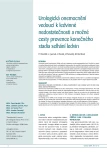UROLOGICAL DISEASES CONTRIBUTING TO RENAL INSUFFICIENCY AND POSSIBLE WAYS OF END STAGE RENAL DISEASE PREVENTION
Authors:
P. Navrátil; L. Lyerová; I. Novák; J. Pacovsky; M. Romžová
Authors‘ workplace:
Transplantační centrum při Urologické klinice FN a LF UK v Hradci Králové, Klinika nefrologie, IKEM Praha
Published in:
Urol List 2009; 7(1): 6-12
Overview
Chronic renal insufficiency (CHRI) may be the consequence of many pathological phenomena. The most frequent is the terminal result of almost all nephrological diseases. Sometimes it could be due to the irreversible damage of the kidney function from others reasons. There we can count on the intoxication with nephrotoxic substances, serious injuries of both kidneys, oncological diseases and others urological benign disorders.
The etiology of the CHRI on the strength of the benign urological diseases is not unusual in urological patients. In many cases their importance was undervalued with following incorrect therapy or absence of the therapy. We meet with undetected urological diseases or with the bad diagnosis of these diseases.
The experience and the foresight of the potential major damage of the kidney function on the strength of urological disorders are very important and it has specific features. In many cases we can prevent it or put it off.
KEY WORDS:
chronic renal insufficiency, acute renal failure, waiting list, transplantation, urological disease
Sources
1. Český registr biopsií 1994–2006. Česká nefrologická společnost.
2. Werner DE, Tighiouart H, Elsayed EF et al. Uric acid and incident kidney disease in the community. J Am Soc Nephrol 2008; 19 : 1204–1211.
3. Karecuk L, Schreuder MF, Wolf AS. Renal tract malformation: perspectives for nefrologists. Nat Clin Pract Nefrology 2008; 4 : 312–324.
4. Taal MW, Brenner BM. Predicting initiation and progression of chronic kidney disease: developing renal risk scores. Kidney Int 2006; 70 : 1694–1705.
5. Taal MW, Brenner BM. Renal risk scores: progress and prospects. Kidney Int 2008; 73 : 1216–1219.
6. Tesař V. Perspektivy: Renální riziko. Postgraduální nefrologie 2008; 4(4): 50–52.
7. Ročenka dialyzační léčby v ČR za rok 2007. Za Českou nefrologickou společnost zpracovali doc. MUDr. I. Rychlík a doc. Ing. F. Lopot.
8. Wavamuno MD, Hartus DC. The need for early nephrology referral. Kidney Int Suppl 2005; 94 : 128–132.
9. Oldrizzi L. Collaboration between nephrologists, cardiologists and diabetologists and the importance of early diagnosis of chronic kidney disease. G Ital Nefrol 2008; 25(Suppl 42): 8–13.
10. Dvořáček J. Vrozené vady ledvin a horních močových cest. In: Dvořáček J et al. Urologie. Praha: ISV 1998 : 517–570.
11. Kočvara R. Vrozené vady dolních močových cest. In: Dvořáček J et al. Urologie. Praha: ISV 1998 : 570–603.
12. Novák I, Matějovič M, Černý V et al. Akutní selhání ledvin. Praha: Maxdorf 2008 : 47.
13. Nakai H, Asanuma H, Shisido S et al. Changing concept in urological management of the congenital anomalies of kidney and urinary tract, CAKUT. Pediatr Int 2003; 45 : 634–641.
14. Pacovský J, Navrátil P, Hladík P et a. Per-forující divertikulitida tračníku – závažná kompli--kace transplantace ledviny. Urológia 2003; 9(3): 27–30.
15. Dvořáček J. Obstrukční uropatie. In: Dvořáček J et al. Urologie. Praha: ISV 1998 : 501–506.
16. Navrátil P. Praktická urologie u nemocných v dialyzační léčbě, před a po transplantaci ledviny. Hradec Králové: Olga Čermáková 2005 : 34.
Labels
Paediatric urologist UrologyArticle was published in
Urological Journal

2009 Issue 1
Most read in this issue
- UROLOGICAL COMPLICATIONS AFTER KIDNEY TRANSPLANTATION
- UROLOGICAL DISEASES CONTRIBUTING TO RENAL INSUFFICIENCY AND POSSIBLE WAYS OF END STAGE RENAL DISEASE PREVENTION
- SURGICAL TECHNIQUES IN KIDNEY TRANSPLANTATION
- THREE KINDS OF RESOURCES FOR KIDNEY TRANSPLANTATION
